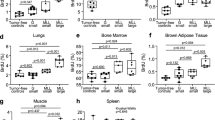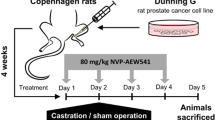Abstract
The effects of the synthetic retinoid N-(4-hydroxyphenyl) retinamide (4-HPR) on prostate cancer metastasis in vivo were evaluated in the mouse prostate reconstitution (MPR) model. MPRs were produced by infection of either heterozygous (+/−) or nullizygous (−/−) p53-mutant fetal prostatic epithelial cells with the recombinant retrovirus Zipras/myc 9. Previous studies have documented that loss of p53 function potentiates metastasis in this model system. MPRs were grafted into homozygous (+/+) p53 male mice, fed a 4-HPR containing diet or a control diet and maintained until the status of tumor progression dictated sacrifice. Under these experimental conditions, treatment with 4-HPR did not have a significant effect on primary tumor wet weight for either p53 +/− or p53 −/− MPRs. For, p53 +/− MPRs the animals fed the 4-HPR diet had a slight improvement in survival and a significant reduction in the number of mesenteric metastases (P=0.0477, t-test). Notably, in p53 +/− MPRs the incidence of metastasis to lumbar spine and sternum was 92% in the control animals compared to 54% in the 4-HPR treated animals (P=0.035, χ2-test). In p53 −/− MPRs there was a trend toward a reduction in the number of soft tissue metastases to lung and liver in the 4-HPR group relative to the control diet group and a statistically significant reduction in the incidence of metastasis to bone was demonstrated in that 50% of control animals versus 30% of 4-HPR treated p53 −/− animals harbored bone metastases (P=0<0.05, χ2-test). Cell lines were established from portions of the primary tumor and from selected metastatic deposits in each experimental group. Clonal analysis, by retroviral integration pattern, indicated increased clonal diversity in both the primary tumors and metastasis-derived cell lines from 4-HPR treated animals relative to the control animals. In vitro treatment with 4-HPR did not reveal discriminating differences between cell lines derived from primary tumors and bone metastases or control and treatment groups in regard to growth arrest or apoptotic responses. Overall these studies indicate limited anti-tumor and anti-metastatic activity in this highly aggressive in vivo mouse model of prostate cancer, yet 4-HPR treatment significantly suppressed the development of bone metastases in p53 +/− and p53 −/− MPRs revealing a novel and potentially clinically useful activity of this retinoid.
Similar content being viewed by others
References
Greenlee RT, Murray T, Bolden S et al. Cancer statistics, 2000. CA Cancer J Clin 2000; 50: 7–33.
Sakr WA, Macoska JA, Benson PD et al. Allelic loss in locally metastatic, multi-sampled prostate cancer. Cancer Res 1994; 54: 327–7.
Qian J, Bostwick DG, Takashi S et al. Chromosomal anomalies in prostatic intraepithelial neoplasia and carcinoma detected by fluorescence in situ hybridization. Cancer Res 1995; 55: 5408–14.
Thompson TC, Park SH, Timme TL et al. Loss of p53 function leads to metastasis in ras+myc-initiated mouse prostate cancer. Oncogene 1995; 10: 869–79.
Thompson TC, Timme TL, Sehgal I. The role of p53 in prostate cancer progression. In Fortner J and Sharp P (eds): Accomplishments in Cancer Research. Philadelphia: Lippincott-Raven Publishers 1996; 280–9.
Thompson TC, Timme TL, Park SH, et al. Mouse prostate reconstitution model system: A series of in vivo and in vitro models for benign and malignant disease. Prostate 2000; 43: 248–54.
Ohori M, Wheeler TM, Kattan MW et al. Prognostic significance of positive surgical margins in radical prostatectomy specimens. J Urol 1995; 154: 1818–24.
Zeitman AL, Edelstein RA, Coen JJ et al. Radical prostatectomy for adenocarcinoma of the prostate: The influence of preoperative and pathologic findings on biochemical disease-free outcome. Urology 1994; 43: 828–33.
Thompson TC. In situ gene therapy for prostate cancer. Oncol Res 1999; 11: 1–8.
Sporn MB, Dunlop NM, Newton DL et al. Prevention of chemical carcinogenesis by vitamin A and its synthetic analogs (retinoids). Fed Proc 1976; 35: 1332–38.
Moon RC, Grubbs CJ, Sporn MB. Inhibition of 1.2-dimethylbenz (a) anthracene induced mammary carcinogenesis by retinyl acetate. Cancer Res 1976; 36: 2626–30.
Anzano MA, Byers SW, Smith JM et al. Prevention of breast cancer in the rat with 9-cis-retinoic acid as a single agent and in combination with tamoxifen. Cancer Res 1994; 54: 4614–17.
Pollard M, Luckert PH, Sporn MB. Prevention of primary prostate cancer in Lobund-Wistar rats by N-(4-hydroxyphenyl) retinamide. Cancer Res 1991; 51: 3610–1.
Pollard M, Luckert PH. The inhibitory effect of 4-hydroxyphenyl retinamide (4-HPR) on metastasis of prostate adenocarcinoma III cells in Lobund-Wistar rats. Cancer Lett 1991; 59: 159–63.
Slawin K, Kadmon D, Park SH et al. Dietary fenretinide, a synthetic retinoid decreases the tumor incidence and the tumor mass of ras+myc-induced carcinomas in the mouse prostate reconstitution model system. Cancer Res 1993; 53: 4461–65.
Gaetano C, Melchiori A, Albini A et al. Retinoic acid negatively regulates b4 integrin expression and suppresses the malignant phenotype in a Lewis lung carcinoma cell line. Clin Exp Metastasis 1994; 12: 63–72.
Kadmon D, Thompson TC. Chemoprevention in prostate cancer. In Vogelzang NJ, Scardino PT, Shipley WU, Coffey DS (eds): Comprehensive Textbook of Genitourinary Oncology. Baltimore, Maryland: Williams and Wilkins 1996; 657–67.
Timme TL, Thompson TC. Rapid allelotype analysis of p53 knockout mice. Biotechniques 1994; 17: 460–3.
Thompson TC, Southgate J, Kitchner G, et al. Multi-stage carcinogenesis induced by ras and myc oncogenes in a reconstituted organ. Cell 1989; 56: 917–30.
Baley PA, Yoshida K, Qian W et al. Progression to androgen insensitivity in a novel in vitro mouse model for prostate cancer. J Steroid Biochem Mol Biol 1995; 52: 403–13.
Ren C, Yang G, Timme TL et al. Reduced lysyl oxidase mRNA levels in experimental and human prostate cancer. Cancer Res 1998; 58: 1285–90.
Darzynkiewicz Z, Crissman HA. Methods in Cell Biology, Vol. 33 Flow Cytometry. New York: Academic Press 1990; 716 pp.
Author information
Authors and Affiliations
Rights and permissions
About this article
Cite this article
Shaker, M.R., Yang, G., Timme, T.L. et al. Dietary 4-HPR suppresses the development of bone metastasis in vivo in a mouse model of prostate cancer progression. Clin Exp Metastasis 18, 429–438 (2000). https://doi.org/10.1023/A:1010905309570
Issue Date:
DOI: https://doi.org/10.1023/A:1010905309570




